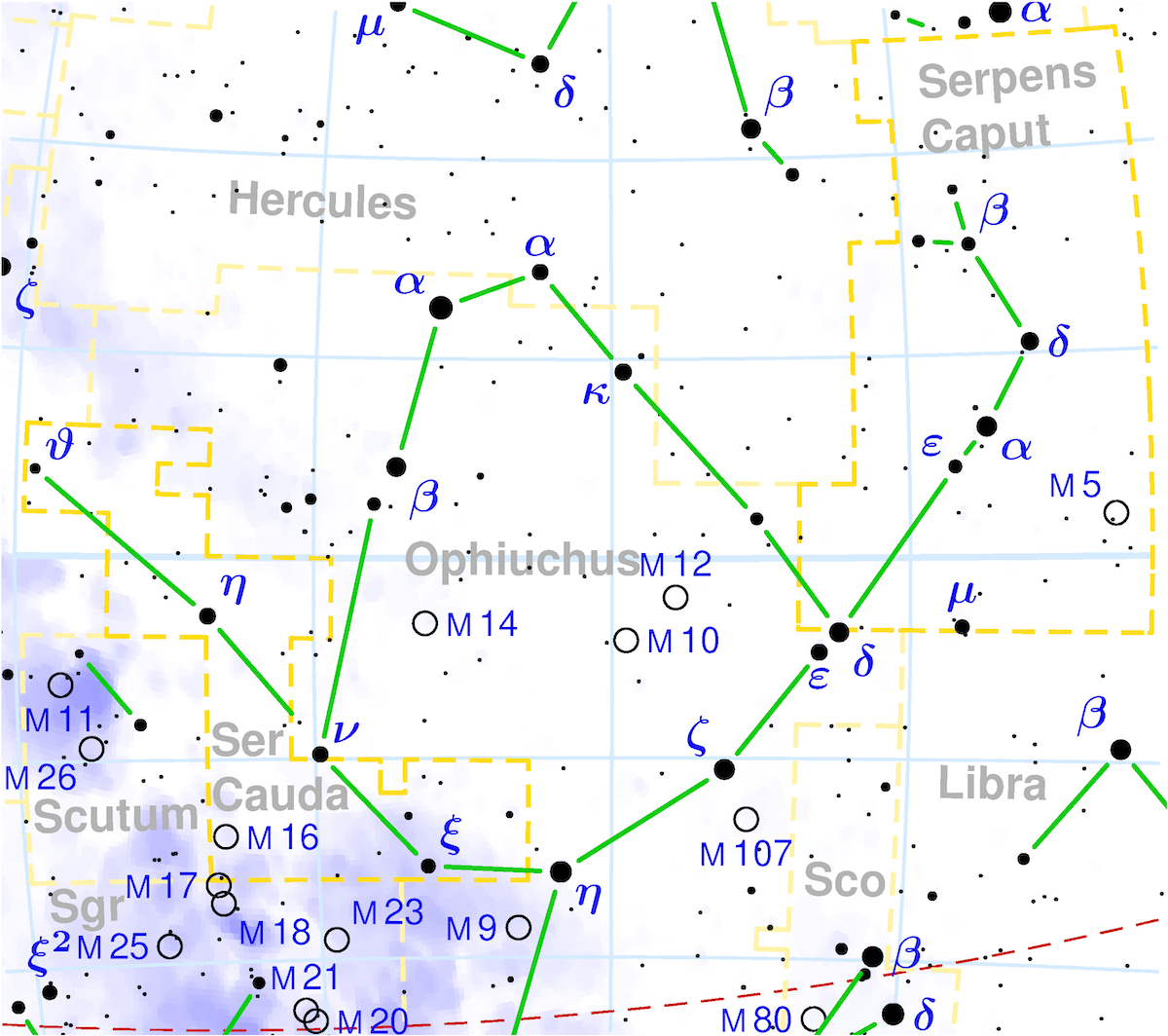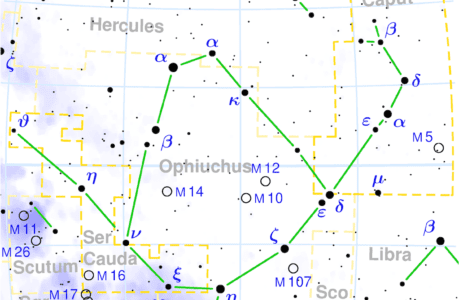The night sky has always been a source of wonder and amazement for humans. The stars, constellations, and galaxies have always intrigued us with their beauty and mysteries. One of the most fascinating constellations in the night sky is Serpens, the serpent constellation. Serpens is a constellation that is visible from Ireland, and in this article, we will guide you on how to view it from Ireland, its history, mythology, and interesting facts.
History:
The Serpens constellation has a long and interesting history. It was first catalogued by the Greek astronomer Ptolemy in the 2nd century AD. The constellation was divided into two parts, Serpens Caput (the serpent’s head) and Serpens Cauda (the serpent’s tail), by the Dutch astronomer Petrus Plancius in the 16th century.
Mythology:
The mythology behind the Serpens constellation is also fascinating. In Greek mythology, Serpens represents the snake that was sent by Hera to kill Hercules while he was still an infant. However, Hercules strangled the snake with his bare hands, and it became one of his many heroic deeds. In another myth, Serpens represents the snake that was sent by Apollo to kill the crow that was stealing his water. The snake was eventually turned into stone by Apollo.
Viewing from Ireland:
To view the Serpens constellation from Ireland, you need to know when it is visible and where to look. The best time to view Serpens is during the summer months, when it is high in the sky. To find Serpens, look for the bright star Vega in the constellation Lyra. Serpens is located just to the east of Lyra, and it is visible as a winding line of stars.
Interesting facts:
Here are some interesting facts about the Serpens constellation:
- The Serpens constellation is one of the smallest constellations in the night sky, but it is still visible from Ireland.
- Serpens contains a number of interesting objects, including the Eagle Nebula, the Omega Nebula, and the Red Spider Nebula.
- The Eagle Nebula, also known as the Pillars of Creation, is a star-forming region that was made famous by the Hubble Space Telescope.
- The Omega Nebula is a cloud of gas and dust that is currently forming new stars.
- The Red Spider Nebula is a planetary nebula, which is the glowing shell of gas and dust that is left behind when a star like our Sun dies.
The Serpens constellation is one of the most fascinating constellations in the night sky, and it is visible from Ireland. Its history, mythology, and interesting facts make it a must-see for stargazers and astronomers alike. By following the guide we provided, you can easily view the Serpens constellation and appreciate its beauty and significance.
How can I see the constellation of Serpens from Ireland?
To see the Serpens constellation from Ireland, you need to know when it is visible and where to look. The best time to view Serpens is during the summer months, when it is high in the sky.
Here are the steps to find the Serpens constellation:
- Find a location with minimal light pollution: To see the stars and constellations clearly, you need to find a location with minimal light pollution. The best places to view the night sky in Ireland are usually in rural areas away from the city lights.
- Look for the bright star Vega: To find the Serpens constellation, first look for the bright star Vega in the constellation Lyra. Vega is a bright blue-white star that is visible in the northeast sky during the summer months. It is one of the brightest stars in the sky and is easy to spot.
- Look to the east of Vega: Once you have located Vega, look to the east of it, and you should see the Serpens constellation. Serpens is located just to the east of Lyra, and it is visible as a winding line of stars.
- Use a star chart or mobile app: If you’re having trouble finding the Serpens constellation, you can use a star chart or a mobile app that will help you locate it. There are many star chart apps available for free that can be downloaded on your smartphone or tablet.
By following these steps, you should be able to find the Serpens constellation and appreciate its beauty and significance. It’s a great way to explore the night sky and discover the wonders of the universe from Ireland.
The mythology of the constellation of Serpens
The Serpens constellation, also known as the serpent constellation, has a fascinating mythology associated with it. The mythology of Serpens dates back to ancient times and has been passed down through the generations.
In Greek mythology, Serpens represents the serpent that was sent by Hera to kill Hercules while he was still an infant. Hera, the wife of Zeus, was jealous of Hercules, who was the son of Zeus and a mortal woman named Alcmene. Hera sent the serpent to kill Hercules, but Hercules, even as an infant, was strong enough to strangle the serpent with his bare hands, which became one of his many heroic deeds.
Another myth associated with the Serpens constellation is related to the Greek god Apollo. According to this myth, Apollo owned a sacred water fountain guarded by a crow. One day, the crow stole the water from the fountain, and Apollo, angry and vengeful, sent a snake (Serpens) to kill the crow. However, before the snake could reach the crow, the bird transformed into a constellation, known today as Corvus, the crow constellation.
In another Greek myth, the Serpens constellation is associated with Asclepius, the god of medicine. Asclepius was known for his healing powers, and he was often depicted holding a serpent-entwined staff, which is still used as a symbol of medicine today. According to the myth, Asclepius was able to bring the dead back to life, which angered the god of the underworld, Hades. In retaliation, Hades asked Zeus to kill Asclepius with a thunderbolt. However, in honour of Asclepius’ healing powers, Zeus placed his image in the sky as the constellation Serpens.
In Chinese mythology, the Serpens constellation is associated with a story of two lovers, Niu Lang (the Cowherd) and Zhi Nu (the Weaver Girl). According to the legend, the two lovers were separated by the Milky Way and were only allowed to meet once a year on the seventh day of the seventh lunar month. The Cowherd and the Weaver Girl are represented by the stars in the constellations Lyra and Aquila, respectively, with the Serpens constellation forming the bridge between them.
Overall, the mythology of the Serpens constellation is rich and varied, with stories from different cultures and time periods. The constellation’s association with serpents, medicine, and heroism has made it a fascinating subject of study and contemplation for astronomers and mythology enthusiasts alike.
The Stars in the constellation of Serpens
The Serpens constellation, also known as the serpent constellation, is a small but interesting constellation in the night sky. The constellation is divided into two parts: Serpens Caput (the serpent’s head) and Serpens Cauda (the serpent’s tail). Here are some of the notable stars in the Serpens constellation:
- Alpha Serpentis (Unukalhai): Alpha Serpentis is the brightest star in the Serpens constellation. It is an orange giant star located in the Serpens Caput region of the constellation. Unukalhai means “the neck of the snake” in Arabic.
- Beta Serpentis (Chow): Beta Serpentis is a yellow giant star located in the Serpens Caput region of the constellation. It is also known as Chow, which means “the claw” in Chinese.
- Eta Serpentis: Eta Serpentis is a multiple star system located in the Serpens Cauda region of the constellation. It is an eclipsing binary star, which means that the two stars orbit each other and periodically eclipse each other.
- Delta Serpentis: Delta Serpentis is a binary star system located in the Serpens Cauda region of the constellation. It consists of two blue-white stars that orbit each other.
- Mu Serpentis: Mu Serpentis is a triple star system located in the Serpens Cauda region of the constellation. It consists of two yellow-white stars and a red dwarf star that orbit each other.
- HD 168723: HD 168723 is a star located in the Serpens Cauda region of the constellation. It is notable because it has a planet, HD 168723b, orbiting around it.
In addition to these stars, the Serpens constellation also contains several interesting objects, including the Eagle Nebula, the Omega Nebula, and the Red Spider Nebula. These nebulae are regions of gas and dust where new stars are formed. The Eagle Nebula is particularly famous for its “Pillars of Creation,” which are columns of gas and dust that are being sculpted by the light of nearby stars. The Omega Nebula is also a star-forming region, while the Red Spider Nebula is a planetary nebula, which is the glowing shell of gas and dust that is left behind when a star like our Sun dies.
Deep sky objects visible in the Constellation of Serpens
The Serpens constellation, also known as the serpent constellation, contains several fascinating deep sky objects that are visible from Earth. Here are some of the most notable deep sky objects in the Serpens constellation:
- Eagle Nebula (M16): The Eagle Nebula, also known as Messier 16 or M16, is a star-forming region located in the Serpens Cauda region of the constellation. The nebula is famous for its “Pillars of Creation,” which are columns of gas and dust that are being sculpted by the light of nearby stars. The Eagle Nebula is a popular target for amateur astronomers and astrophotographers.
- Omega Nebula (M17): The Omega Nebula, also known as Messier 17 or M17, is another star-forming region located in the Serpens Cauda region of the constellation. The nebula is shaped like a swan, with its long neck and body extending across the sky. The Omega Nebula is also a popular target for astrophotographers and amateur astronomers.
- Red Spider Nebula (NGC 6537): The Red Spider Nebula, also known as NGC 6537, is a planetary nebula located in the Serpens Caput region of the constellation. The nebula is the glowing shell of gas and dust that is left behind when a star like our Sun dies. The Red Spider Nebula is notable for its bright red colour, which comes from ionised hydrogen gas.
- Serpens South (IC 4628): Serpens South, also known as IC 4628, is a large emission nebula located in the Serpens Cauda region of the constellation. The nebula contains several star-forming regions and is often overlooked by amateur astronomers due to its faintness.
- Serpens North (IC 4756): Serpens North, also known as IC 4756, is an open star cluster located in the Serpens Caput region of the constellation. The cluster contains around 100 stars and is notable for its distinctive shape, which resembles a diamond.

